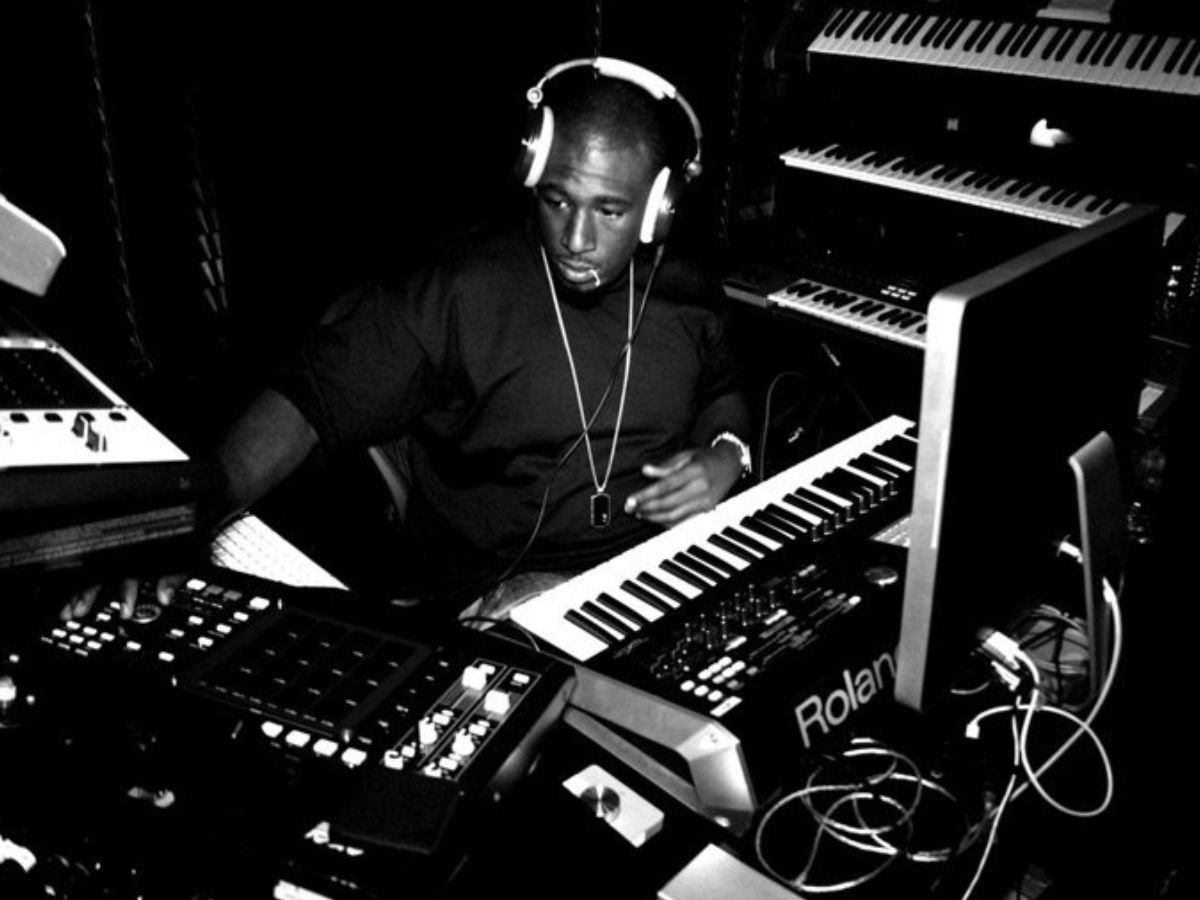

Hip Hop
How To Mix Hip-Hop Vocals
Published: December 30, 2023
Learn the step-by-step process of mixing Hip Hop vocals to achieve professional-quality sound. Master the art of blending and enhancing vocals for a captivating Hip Hop track.
(Many of the links in this article redirect to a specific reviewed product. Your purchase of these products through affiliate links helps to generate commission for AudioLover.com, at no extra cost. Learn more)
Table of Contents
Introduction
Welcome to the world of hip-hop vocals. Mixing vocals in hip-hop is a crucial step in creating a polished and professional sound. It’s the process of taking raw vocal recordings and transforming them into a cohesive and impactful element of the music.
Whether you’re an artist looking to mix your own vocals or an engineer tasked with mixing vocals for a hip-hop track, this guide will provide you with the essential techniques and insights to achieve outstanding vocal mixes.
Mixing hip-hop vocals is unique because the vocals often take center stage in the mix. They need to be clear, upfront, and blend seamlessly with the instrumental elements. In this article, we’ll discuss everything from choosing the right microphone to adding effects and automating vocal levels.
Before we dive into the technical aspects of mixing hip-hop vocals, it’s important to note that a great mix starts with a great recording. Make sure the vocals are recorded in a treated environment with a quality microphone and preamp. The better the recording quality, the easier it will be to achieve a professional mix.
Now, let’s jump into the world of hip-hop vocal mixing and uncover the techniques that will elevate your vocal mixes to new heights.
Choosing the Right Microphone
When it comes to mixing hip-hop vocals, choosing the right microphone is essential. Different microphones have different characteristics and can greatly impact the sound and tone of the vocals. Here are a few factors to consider when selecting a microphone:
- Type of Microphone: There are various types of microphones to choose from, including dynamic, condenser, and ribbon microphones. Dynamic microphones are rugged and can handle high sound pressure levels, making them suitable for energetic performers. Condenser microphones are more sensitive and capture more details, making them a popular choice for studio recording. Ribbon microphones have a vintage sound and smooth high-frequency response.
- Polar Pattern: The polar pattern determines how the microphone captures sound. The most common polar patterns are cardioid (captures sound primarily from the front), supercardioid/ hypercardioid (captures sound from the front with some side rejection), and omnidirectional (captures sound from all directions). Consider the recording environment and the desired sound when choosing a polar pattern.
- Frequency Response: The frequency response of a microphone refers to how it captures different frequencies. Each microphone has a specific frequency response curve, which can affect the tonal characteristics of the vocals. Consider whether you want a microphone with a flat response for accuracy, or one with a boosted or diminished frequency range for added character.
- Budget: Another important consideration is your budget. While high-end microphones can provide exceptional quality, there are also affordable options that can deliver great results. Remember that a higher price tag doesn’t always guarantee the best sound for your specific needs.
- Experimentation: Ultimately, the best way to choose the right microphone is to experiment. Try out different microphones and see which one complements the artist’s voice and fits the style of the song. Trust your ears and listen for clarity, presence, and overall tonality.
Remember, the microphone you choose will have a significant impact on the final vocal sound, so take your time, do some research, and explore different options. It’s worth investing in a quality microphone that suits your recording environment and the artistic vision of the project.
Setting Up Your Recording Space
Creating a suitable recording space is crucial for capturing high-quality vocals. While professional studios have dedicated vocal booths, you can still achieve excellent results in a home or makeshift studio. Here are some tips to set up your recording space:
- Avoid Reflective Surfaces: Reflections can cause unwanted echoes and reverb in your recordings. To minimize this, avoid recording in rooms with hard, reflective surfaces like glass windows or bare walls. Consider using sound-absorbing materials, such as acoustic panels, foam, or blankets, to reduce reflections.
- Control Background Noise: External noises can create distractions and degrade the quality of your vocal recordings. Choose a quieter room or time of day for recording. If needed, use noise reduction techniques like closing windows, turning off fans or air conditioning, and using a noise gate or noise reduction plugin during the mixing process.
- Position the Artist Properly: The positioning of the artist in relation to the microphone can greatly affect the sound. Place the microphone at a comfortable height for the artist and position it slightly off-center for a smoother sound. Experiment with different distances and angles to find the best placement for capturing the desired vocal tone.
- Use Proper Acoustic Treatment: If possible, invest in some acoustic treatment for your recording space. This can include bass traps to control low-end frequencies, diffusers to scatter sound reflections, and acoustic panels to absorb excess reverberation. Proper acoustic treatment helps create a controlled and accurate recording environment.
- Ensure Good Ventilation and Temperature: It’s important to maintain a comfortable environment for the artist during recording sessions. Proper ventilation and temperature control can prevent discomfort and fatigue, allowing the artist to deliver their best performance.
Remember, even with limited resources, you can create a favorable recording space by using creative solutions and taking steps to control the environment. The goal is to provide an environment that minimizes distractions, unwanted reflections, and external noises, enabling the artist to focus on delivering their best vocal performance.
Mic Placement Techniques
Proper mic placement is crucial when recording vocals, as it can significantly impact the quality and tonality of the recorded sound. Here are some mic placement techniques you can try:
- Close Mic Technique: The close mic technique involves placing the microphone close to the vocalist’s mouth, typically about six inches away. This technique captures more intimate and detailed vocals while minimizing background noise. It is commonly used for rap vocals or when you want a more upfront and intimate vocal sound.
- Mid Mic Technique: The mid mic technique involves positioning the microphone slightly above the vocalist’s mouth, around 12-18 inches away. This technique allows for a bit more room sound to be captured, resulting in a more natural and spacious vocal sound. It works well for capturing dynamic vocal performances.
- Room Mic Technique: The room mic technique involves placing a microphone further away from the vocalist to capture more of the room acoustics. This technique is useful when you want to add a sense of depth and ambiance to the vocals. Experiment with different distances and angles to find the sweet spot that complements the vocal sound.
- Panning Technique: While not directly related to mic placement, panning plays a significant role in creating a stereo image with vocals. For a wider sound, try panning multiple vocal tracks slightly to the left and right. This creates a sense of depth and dimension in the mix.
When experimenting with mic placement, it’s important to consider the desired sound, style of the song, and the vocalist’s unique characteristics. Trust your ears and listen for balance, clarity, and how the vocals sit in the mix. Sometimes subtle adjustments in mic placement can make a significant difference in the final sound.
Remember, every vocalist and recording space is different, so it’s important to experiment and find the mic placement technique that works best for each specific situation. Take the time to fine-tune the microphone positioning until you achieve the desired vocal sound for your hip-hop mix.
Vocal Compression and EQ
Once you have recorded the vocals, it’s time to process them using compression and EQ techniques to enhance their clarity, balance, and overall presence in the mix. Here’s how you can effectively apply compression and EQ to your hip-hop vocals:
- Compression: Compression helps to control the dynamic range of the vocals, reducing the volume of louder sections and boosting the volume of quieter sections. This creates a more consistent and polished sound. Start with a moderate compression ratio (around 2:1 or 4:1), adjust the threshold to catch the louder peaks, and set an appropriate attack and release time for smooth leveling. Experiment and trust your ears to find the right balance.
- EQ: EQ is used to shape the tonal balance of the vocals and ensure they sit well in the mix. Start by cutting any unwanted low-end rumble or excessive high frequencies. Then, make slight boosts or cuts in the mid-range frequencies to enhance clarity and address any frequency masking issues. Gentle boosts or cuts in certain frequency bands can also help to add character and emphasize desired vocal qualities.
- De-Essing: De-essing is a technique used to reduce or eliminate harsh sibilance sounds (such as “s” and “sh” sounds) that can be distracting. Use a de-esser plugin or manually automate the volume when these sounds occur. Aim for a natural reduction in sibilance without overly affecting the overall vocal sound.
- Vocal Effects: Depending on the artistic vision of the track, you may want to experiment with adding effects to the vocals. Common effects used in hip-hop vocals include reverb, delay, and modulation effects like chorus or flanger. Apply these effects subtly to enhance the vocal sound and create depth and texture.
While the above techniques provide a general guideline, every vocal recording is unique, so trust your ears and make adjustments that suit the specific characteristics of the vocals and the style of the song. It’s also important to listen to the vocals in the context of the entire mix to ensure they blend well with the instrumental elements.
Remember, the aim of vocal compression and EQ is to enhance the vocals without drastically altering their natural qualities. The goal is to create a balanced and polished vocal sound that captures the essence of the artist’s performance while fitting seamlessly into the overall mix.
Adding Effects to Enhance Vocals
In the world of hip-hop, adding effects to vocals can take your mix to the next level, adding depth, texture, and creativity. Here are some popular effects used to enhance hip-hop vocals:
- Reverb: Reverb is a commonly used effect that adds space and creates a sense of depth in the vocals. It simulates the natural reverberation of a room or space. Experiment with different reverb types and settings to find the right amount of decay and tone that fits the vibe of the song.
- Delay: Delay adds echo and repetition to the vocals, which can create a sense of movement and excitement. It can be used subtly for an ambient effect or dialed up to create a more pronounced rhythmic effect. Adjust the delay time, feedback, and blend to achieve the desired result.
- Chorus: Chorus adds a thickening effect to the vocals by duplicating the original signal, slightly detuning it, and modulating the pitch. This creates a sense of width and richness. Use chorus sparingly, as too much can make the vocals sound unnatural. It works well for creating harmonies or adding a dreamy quality to the vocals.
- Flanger/Phaser: Flanger and phaser effects add a swirling, sweeping, or pulsating effect to the vocals. They can add movement and intrigue to the vocal sound. Experiment with different rates and feedback settings to achieve the desired effect without overpowering the vocals.
- Pitch Correction: Pitch correction can be a useful tool to correct any minor tuning issues in the vocals. Use it subtly to ensure that the vocals stay in tune without sounding overly processed or robotic. Keep in mind that preserving the natural imperfections can add character and authenticity to the vocals, so use pitch correction sparingly and with taste.
When using effects, it’s important to maintain a balance between enhancing the vocal sound and maintaining clarity and intelligibility. Avoid overwhelming the vocals with excessive effects that may distract from the lyrics or the strength of the performance.
Remember, the purpose of adding effects is to enhance and complement the vocals, not to mask or disguise them. Use your creative judgment to find the right combination of effects that enhances the desired mood and emotion of the song while allowing the vocals to shine through.
Creating a Stereo Image
Creating a wide and immersive stereo image for hip-hop vocals can greatly enhance the overall mix and make it more engaging for the listener. Here are some techniques to help you create a spacious stereo image for your vocals:
- Panning: Pan the vocal tracks slightly left and right to create a sense of width and separation. This helps to position the vocals in the stereo field and create a three-dimensional soundstage. Be subtle with your panning adjustments to avoid creating an unnatural or unbalanced mix.
- Doubling or Layering: Duplicate the vocal tracks and slightly alter the timing or pitch of the duplicate. Pan each track to opposite sides to create a thicker, wider vocal sound. Experiment with the timing and pitch adjustments to find the sweet spot that adds depth without sounding unnatural.
- Stereo Effects: Utilize stereo effects, such as stereo reverb or stereo delay, to add width and spaciousness to the vocals. By applying these effects, you can create a sense of depth and ambience in the stereo image. Adjust the wet/dry mix of the effect to control the intensity and blend it subtly with the dry vocals for a more natural sound.
- Background vocals and ad-libs: Incorporate background vocals and ad-libs panned in different positions to add depth and movement to the vocal arrangement. This technique can create a dynamic and engaging stereo image, with the main vocals in the center and supporting vocals spread out across the stereo field.
- Stereo Width Control: Use stereo width control plugins or techniques to fine-tune the stereo image. These tools allow you to adjust the stereo width of specific frequency bands, allowing you to selectively widen or narrow certain parts of the vocal sound to enhance the overall stereo image.
Remember, the goal of creating a stereo image is to provide a sense of space and width while maintaining a cohesive and balanced mix. It’s essential to listen critically and make adjustments that complement the overall sound and arrangement of the song.
Keep in mind that not all vocals need a wide stereo image. Some songs may benefit from a more focused and centered vocal sound. Trust your ears and make creative decisions that serve the vision of the song and the artistic expression of the vocals.
Automating Vocal Levels
Automating vocal levels is a powerful technique that allows you to control the volume of the vocals throughout the song. It ensures that the vocals sit well in the mix and maintain a consistent presence, especially when the dynamics of the performance vary. Here’s how you can effectively automate vocal levels:
- Verse and Chorus Balancing: One common use of automation is to balance the vocal levels between different sections of the song, such as verses and choruses. Adjust the vocal levels manually or use automation tools to ensure that the vocals are appropriately emphasized during the chorus sections, giving them a boost in volume and impact.
- Phrase and Word Dynamics: With automation, you can also fine-tune the vocal levels within specific phrases or words. For example, you can bring up the volume of a particular phrase to emphasize its importance or reduce the volume of certain words to achieve a more nuanced and controlled vocal delivery.
- Adapting to Instrumental Changes: Sometimes, the instrumental arrangement of a song may change throughout different sections. Automation allows you to adjust the vocal levels to adapt and blend seamlessly with these changes. For instance, if a section gets more intense, you can increase the vocal volume to match the energy of the instruments.
- Breath Control: Automation can also be used to manage breaths in vocal recordings. You can reduce the volume of breaths between phrases to maintain a smooth and uninterrupted vocal performance. By automating breaths, you can create a more polished and professional vocal sound.
- Vocal Expression: Automation can play a key role in enhancing the emotional impact of a vocal performance. Use gentle volume adjustments to accentuate moments of intensity, vulnerability, or passion in the vocals, allowing the emotion to shine through.
When automating vocal levels, it’s important to listen attentively to ensure the changes are seamless and natural. Smooth transitions and adjustments that match the artistic intent of the performance are essential. Consider using automation tools within your digital audio workstation (DAW) to make the process more precise and efficient.
Don’t be afraid to experiment and trust your ears when automating vocal levels. Every vocal recording is unique, so take the time to fine-tune the automation to achieve the desired balance and dynamics that best serve the song.
Tips for Vocal Mixing in Hip-Hop
Mixing vocals in hip-hop requires attention to detail and a solid understanding of the genre’s specific characteristics. Here are some tips to help you achieve a polished and professional vocal mix in hip-hop:
- Focus on Clarity: Hip-hop vocals need to be clear and intelligible. Use EQ to carve out space for the vocals in the mix and address any frequency masking issues. Cut any unnecessary low-end rumble or harsh high frequencies that can detract from the clarity of the vocals.
- Pay Attention to Timing and Groove: Hip-hop is all about the rhythm. Ensure that the vocals are in sync with the beat and that the delivery aligns with the groove. Use editing tools and techniques, like time stretching or quantizing, to tighten up the vocal timing and make it groove seamlessly with the instrumental elements.
- Add Effects with Purpose: Use effects such as reverb, delay, or modulation sparingly and purposefully. Ensure that the effects enhance the vocals and fit the artistic vision of the song. Experiment with different settings to find the right balance between adding depth and maintaining intelligibility.
- Create Vocal Stacks: Layering or doubling vocals can add thickness and depth to the vocal sound. Experiment with doubling certain sections, creating harmonies, or adding ad-libs to create a fuller and more impactful vocal presence in the mix.
- Use Vocal Buss Processing: Consider applying processing to the vocal buss as a whole to glue the vocals together. Use gentle compression or EQ to achieve cohesiveness and balance. This can help create a unified vocal sound and make them sit seamlessly with the instrumental elements.
- Balance Vocals with Instrumentation: The vocals should be the focal point in the mix while still blending harmoniously with the instrumental elements. Adjust the vocal levels and EQ to ensure that the vocals cut through the mix without overpowering or getting buried in the instrumentation.
- Pay Attention to Dynamics: Hip-hop vocals often feature dynamic performances. Use compression to control the dynamic range and maintain a consistent volume. But be careful not to over-compress and squash the vocals, as it can drain the energy and impact of the performance.
- Refer to Reference Tracks: Use reference tracks from well-mixed hip-hop songs as a guide to understand the sound aesthetics and dynamics commonly found in the genre. Pay attention to the tonality, spatialization, and overall balance of the vocals in these reference tracks and apply those principles to your mix.
- Trust Your Ears: While technical guidelines are helpful, ultimately, trust your ears. If something doesn’t sound right, make adjustments accordingly. Experiment, take risks, and let your creativity shine through to create a unique and captivating vocal mix.
Remember, every mix is a creative process, and these tips should serve as a starting point for your own experimentation and exploration. Stay attentive, patient, and continue to refine your skills to achieve the best possible vocal mixes in the world of hip-hop.
Conclusion
Mixing vocals in hip-hop is both an art and a science. It requires technical knowledge, a deep understanding of the genre, and a keen ear for detail. By following the tips and techniques outlined in this article, you can take your hip-hop vocal mixes to new heights.
From choosing the right microphone to setting up your recording space, mic placement, vocal compression, EQ, adding effects, creating a stereo image, automating vocal levels, and implementing various mixing strategies, each step plays a crucial role in achieving a professional and impactful vocal sound.
While this guide provides a solid foundation, it’s important to remember that every mix is unique, and creativity is paramount. Trust your ears and use your intuition to make adjustments that serve the artistic vision of the song and bring out the best in the vocals.
Hip-hop vocals should be powerful, clear, and blend seamlessly with the instrumental elements. Aim for a mix that highlights the delivery, emotion, and energy of the performance, while still maintaining balance and cohesion within the overall sonic landscape.
Lastly, don’t be afraid to experiment, take risks, and continue to refine your skills. The journey to mastering hip-hop vocal mixing is ongoing, and through practice and perseverance, you can develop your own signature style and create captivating mixes that leave a lasting impact.
So, embrace the challenges, embrace the creativity, and have fun as you dive into the exciting world of hip-hop vocal mixing. Happy mixing!











